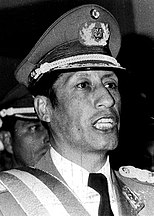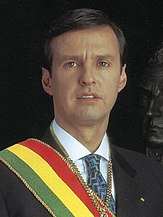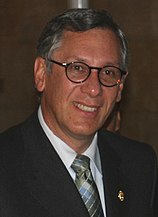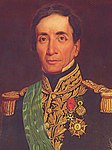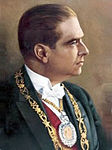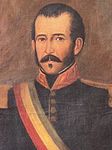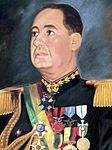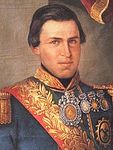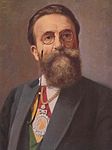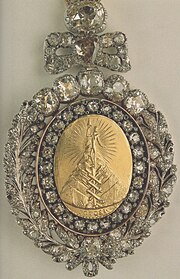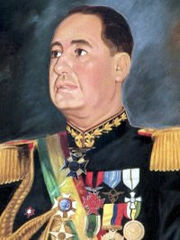Bolivian President
The constitutional president of the Plurinational State of Bolivia is the head of state and government of Bolivia, and is also the captain general of the Armed Forces. In addition, he is the highest authority of the Bolivian Agrarian Reform Service. He composes, together with the vice president and State Ministers, the executive body of the public power of the Bolivian State.
The president and vice president are elected on the same ballot by universal direct suffrage. His mandate lasts for five years, with the right to a single re-election. The current Constitution changed the method to decide the winning formula. If there is not an absolute majority, it will no longer be elected by the Legislative Assembly, but through a second round.
Background
American independence has its origins in the Chuquisaca uprising of May 25, 1809, which is recognized by Hispano-American independentist historiography as the "First Libertarian Cry of America", and its subsequent climax in the revolution of La Paz on July 16 of that year. It means the beginning of the emancipation process of the Spanish colonies in the fight for their independence; In the Bolivian case, this process would culminate successfully in 1825, to later become a republic.
The La Paz revolution is, in fact, the first attempt at independence of the future Bolivia: a Constitutional Statute (first Constitution in America) is issued; the first red and emerald green flag was hoisted; the Guardianship Board of the Rights of the People is created, made up of mestizos, indigenous people, Creoles and patriotic Spaniards; Pedro Domingo Murillo is elected its president, in such a way he is the first president of Hispanic America and in Upper Peru; the government of the Tuitive Board was organized into five ministries: government, war, grace and justice, worship and finance; the Proclamation of the Guardian Board constitutes a Declaration of Independence from Spain, being the first on the continent, and which ends with fidelity to Fernando VII.
However, this independence project ended when the Junta Tuitiva was dissolved, the subsequent capture of the leaders of the revolution and the execution of the population that had participated in it, their punishment depending on the magnitude of their work.
At the end of the American War of Independence, the question of Upper Peru was a complex issue as it was a territory that had belonged at the time to the Viceroyalty of the Río de la Plata and that, according to the thesis of the Uti possidetis iuris, would belong to it in his republican stage; In addition to the existence of territorial claims by the Republic of Peru, which considered itself the owner of the territories of Upper Peru as a viceroyal heritage due to its annexation to the Viceroyalty of Peru in 1810 to 1825, and due to the fact that it had cultural ties with the region from before from the colony. However, the opinion of the upper Peruvians was to make the provinces of Upper Peru independent and their conformation into a republican state.
History
In Bolivia there were a total of 90 governments between constitutional, interim and de facto; with 67 presidents. The first president of Bolivia was Antonio José de Sucre, who took office on December 29, 1825, according to research by the historian Isaac Sandoval, in his book "Political development in the social formation of Bolivia" where he affirms that Sucre was the first president. Previously, there were doubts about who was the first president of Bolivia, since it was thought that Simón Bolívar was the first president, the Bolivian historian Carlos Mesa, author of the book “Entre urnas y fusiles”, a book where it is stated that Bolívar was the first president.Although Sandoval and other historians such as Herland Vhiestrox Herbas, Bismark Cuéllar, among others, affirm that Simón Bolívar was governor and Protector of Bolivia, title granted by the Deliberative Assembly on August 10, 1825.
In 1839 the Bolivian State together with the North Peruvian and South Peruvian States formed the Peru-Bolivian Confederation. Its protector and highest authority of the Executive Power was Andrés de Santa Cruz, elected as Supreme Protector of the Peru-Bolivian Confederation by the Congresses of the three States in the Pact of Tacna on October 28, 1836, simultaneously administering the presidency of the Bolivian State. However, Mariano Enrique Calvo, assumed the interim presidency in replacement of the president, when Santa Cruz was in Peruvian territory in the process of forming the nascent confederation. Throughout this management, Santa Cruz was more aware of military than administrative matters, such as the war for the establishment of the Peru-Bolivian Confederation, the war against the Argentine Confederation and the war against Chile and the Restoring Army. Calvo came to be in the presidential position longer than Santa Cruz, it would even be Calvo who José Miguel de Velasco would end up overthrowing, to end up in this way by declaring the secession of Bolivia from the Peru-Bolivian Confederation.
Throughout Bolivian history there have been four governments made up of triumvirates: the Government Junta of 1861, the Federal Junta of 1899, the Transitional Government Junta 1920-1921 and the Torrelio-Bernal-Pammo Military Junta of 1981. Between 1965 and 1966, René Barrientos and Alfredo Ovando starred in the only case of co-presidency in the history of Bolivia.
In 1930, and because of his aspirations for extensions, Hernando Siles left the command of the nation to his Council of Ministers, breaching the current constitutional norm of 1880, being the only time in the history of the country in which a constituted government did not it was presided over by a representative.
In 2009, with the emergence of the Plurinational State as a result of the promulgation of the Political Constitution of 2009 and the subsequent change of name to the country, leaving behind its previous name of Republic of Bolivia to be in hereafter Plurinational State of Bolivia. In order to comply with the structural changes of the new constitution, it was decided to advance the General Elections to be held on December 6, 2009, with Evo Morales winning again, with 64.22% of the votes. This situation made Evo Morales Ayma the last president of the Republic and the first of the Plurinational State.
The presidential term is currently five years, however in most of the constitutions it is four years, the exceptions are 1843 which considers a period of eight years, that of 1851 five years, 1861 three years, the from 1945 six years, from the reform of 1994 five years.
Bolivarian Constitution
The Political Constitution of Bolivia of 1826, also known as the Bolivarian Constitution, was the first constitutional text prepared by Simón Bolívar, sanctioned by the General Constituent Congress on November 6, 1826 and promulgated by Antonio José de Sucre on November 19. November 1826. In the first instance, the presidency constituted a life position, which could choose and appoint his successor. The President was the moderator Head of State between the four branches of State (Executive, Legislative, Judicial and Electoral), however the Vice President of the Republic was the Head of Government, who was at the head of the Executive Branch.
Article 77. The exercise of executive power lies in a life-saving President, a vice-president and three ministers of State.Political Constitution of 1826, 19 November 1826.
Subsequently, it was abrogated by Andrés de Santa Cruz, through the Political Constitution of 1831, consequently the presidency could no longer be held for life, but for a government period of four years, with the possibility of unlimited re-election Likewise, the president becomes the head of state and government, leaving the vice president with the aim of replacing or supplying the president in case of death, physical impossibility or suspension.
Confederate Constitution
The Fundamental Law of the Peru-Bolivian Confederation of 1837, was issued by the Tacna Congress, and promulgated by Andrés de Santa Cruz, which delegated the exercise of the Executive power of the conforming states to the Protector of the Confederation.
Art. 27.- The executive power of the confederation resides in the supreme chief of it, and in the Ministers of State. The supreme chief will be called Protector of the Peruvian-Bolivian Confederation.Basic Law of the Peruvian Confederation - Bolivian, May 1, 1837
This constitution was abrogated in 1839, by José Miguel de Velasco, declaring the secession of Bolivia from the Peru-Bolivian Confederation, likewise the exercise of the Executive power was restored, and entrusted to the President of the Republic.
Article 65.o.- The Executive Power shall be exercised by a citizen, with the title of President of the Republic and by the Ministers or Secretaries of State. The President of the Republic is responsible for all acts of his administration, as well as the Ministers, each in their respective case and branch.Political Constitution of 1839, 26 October 1839.
Constitution of the Plurinational State
The Political Constitution of the State of 2009, was presented to the National Congress by the Constituent Assembly of 2006, approved through the Referendum of January 25, 2009, and promulgated by Evo Morales on February 7, 2009.
This constitution changes the name of "President of the Republic" by "President of the State".
Article 165.o.- The Executive Body consists of the President or President of the State, the Vice-President or Vice-President of the State, and the Ministers and Ministers of State.2009 Political Constitution, 7 February 2009
Living former presidents
Only 8 former presidents of the 67 presidents who ruled Bolivia remain alive; which are the following:
Constitutional succession
Symbols
Presidential Medal
The presidential medal is a historical piece of great value, considered unique in the Americas, and which is conferred on the President of Bolivia when he assumes the presidency of the country. Together with the presidential band and the baton, it constitutes the presidential symbols of the first president of the country.
It is an American numismatics medal from the XIX century, made of 22-carat gold and adorned with diamonds, minted in the Potosí Mint, and which was a gift to the Liberator Simón Bolívar upon his arrival on Bolivian soil in 1825. The symbolic value of this object is similar to that of "a crown, in the case of monarchies, and of the tiara, if we refer to the Pope".
Presidential Band
The presidential sash is a cloth sash made up of the colors of the Bolivian tricolor flag (red, yellow, and green), with the coat of arms in the center, the cockade, and a tassel; and that together with the medal of the Liberator Simón Bolívar and the command baton, constitute the symbols of the president of Bolivia at the moment of assuming command of the nation.
Each presidential sash is custom designed for the president-elect. Former President Evo Morales included the wiphala in the presidential sash, which became a national symbol with the approval of the Political Constitution of the State of 2009.
The current presidential band used by President Luis Arce includes four national symbols on the yellow stripe; Bolivian coat of arms, wiphala, kantuta and patuju flower.
The presidential sash weighs at least one kilo and its embroidery is made of gold leaf.
Presidential Staff of Command
The presidential baton is a command baton that is delivered to the president of Bolivia, in his capacity as Captain General of the Armed Forces, by the Military High Command, at the moment of taking office the presidency of the country. It is conferred on the president together with the presidential band and the medal of the Liberator Simón Bolívar, both presidential symbols.
The baton of command (or staff of command, also called maniple) is a protocol complement that denotes in the person who carries it, authority or command over a group or collective identity. Its historical background dates back to the first civilizations, and it is currently used in many countries both in the civil and military spheres.
It was regulated during the government of Andrés Santa Cruz, on December 9, 1829. Unlike the presidential medal, it is not a unique element, each president has his own cane and is inscribed with his name.
Government Image
The Image of the Government is an emblem that comes to be configured as the representation of the government administration or mandate of the president in office. The use of own images to represent a specific government administration is a very recent phenomenon in the history of Bolivia, since until the resignation of Evo Morales, all previous governments had only used the Coat of Arms[citation required], as a representative symbol; With the assumption of Jeanine Áñez, some symbolic changes were made, including the implementation of a government image.
Government Palace
The Bolivian Government Palace is the seat of the Executive Branch and office of the Bolivian President. Historically, three different buildings were used as the presidential palace. The Casa Grande del Pueblo is currently in use, which is located on Potosí street, in the city of La Paz next to the Metropolitan Cathedral, and diagonally to the left of the Legislative Palace, where the Plurinational Legislative Assembly is located.
After the independence of Bolivia, in 1825 a building belonging to the Archbishopric of La Plata began to be used, which was expropriated for use as a presidential palace. Later, during the government of Aniceto Arce Ruiz, (1888-1892), the works for the construction of the Great National Palace began in 1892, concluding in 1896, in the government of Severo Fernández Alonso, (1896-1899) was a member of the Conservative Party, which could not face the Federal War, which resulted in the transfer of the Executive Branch to the city of La Paz. As of this event, this building is in charge of the Chuquisaca Prefecture, the current autonomous government of Chuquisaca. Starting to use the Palacio Quemado.
During the government of Evo Morales (2006-2019), in 2014 work began on the construction of a new headquarters of the Executive Power, the Casa Grande del Pueblo, which culminated in 2018, consequently moving the headquarters of the Executive Power to this new building, also being the presidential residence. Meanwhile, the Palacio Quemado was converted into a museum. In the government of Jeanine Añez (2019-2020), the Palacio Quemado was used as the presidential palace, although the ministries and other government offices continued to operate in the building. Currently in the government of Luis Arce, the Casa Grande del Pueblo was resumed again.
Presidential Escort
The Presidential Escort is made up of the Bolivian RI-1 Colorados Infantry Regiment, which is a military unit of the Bolivian Army whose specific mission is to safeguard the security and physical integrity of the President of Bolivia and in charge of which is the custody of the Government Palace and Presidential Residence.
It has two infantry battalions, BI-201 and BI-202, with their respective headquarters, both located in the city of La Paz. The Calama headquarters, located on the street of the same name where the central offices of the unit and the recruitment center are located. The Mirador barracks with a seat on the Quilli Quilli hill, Villa Pavón area, which is a training center in various areas of specialization such as assault, support, personal protection, first aid, etc. They also have dormitories in the Casa Grande del Pueblo for the soldiers who watch and guard the government palace at night to sleep.
Presidential Transport
The Bolivian President is transported by the Bolivian Presidential Air Group. The EC 145 helicopter is used for short-range national transportation of the President, and the Falcon 900EX EASY plane is used for national and international transportation., both manufactured by Dassault Aviation (France) that make up part of the Bolivian Air Force aircraft.
First Lady
First lady is a formal title given to the president's wife. She performs social work and protocol functions by accompanying the President. The current First Lady of Bolivia is Lourdes Brígida Durán Romero, wife of President Luis Arce.
This role is traditionally held by the President's spouse, however when the Chief Executive was divorced, widowed or single, or when the President's spouse was unable to fulfill the role for any reason, the title is also applied to the daughter or sister of the President of the State.
Dynasties
Descendants of the Inca Royal House
Presidential Families
White Family
Ballivián Family
Belzú Family
War Family
Family Laws
Siles Family
Tejada Family
Busch Family
Peace Family
Statistics
Presidents with the rank of Marshal
Of the 67 presidents that Bolivia had, only three reached the highest existing military rank, which are the following:
- Andrés de Santa Cruz, Gran Mariscal de Zepita del Ejército Unida Libertador del Perú, Gran Mariscal del Ejército Peruano y Gran Mariscal del Ejército Boliviano.
- Antonio José de Sucre, Gran Mariscal de Ayacucho of the United Army Libertador of Peru.
- José Ballivián Segurola, Marshal of the Bolivian Army.
Decorated Presidents
- Simon Bolivar, was awarded with the title of Freedom, decorated with a gold medal; studded with shiny, on the reverse appears the hill of Potosi, and the Liberator placed at the end of a scale formed of rifles, swords, cannons and flags, in attitude to set on the top of the hill, the cap of freedom and on the reverse, between an olive and laurel garland, with the following inscription:The Bolivar Republic thanks the hero whose name".
- Antonio José de Sucre, decorated with the title Defender of the Republic of Bolivar and hero of Ayacucho, in consideration for being the architect of the declaration of independence and organization of the Republic of Bolivar, present Bolivia; as well as his performance as General in Chief of the United Liberation Army of Peru in the battle of Ayacucho. Therefore he was told in the name of Congress, with a gold medal, the diamonds, the diamonds, on his reverse engraved "to its excellence, starting Peru", figurated by a vineyard, from among the claws of a lion; and to the reverse the following inscription: "The Bolivar Republic to its defender, hero of Ayacucho”.
- Andrés de Santa Cruz, decorated with the title Great Citizen Restorer of the Homeland, as "a prize to the eminent services it has provided to the cause of American Independence, and to the honor and security of the Republic"
- Mariano Enrique Calvo, decorated with the title Conservative of Peace, title that he could use in his dictates, in consideration for keeping Bolivia's internal order during the war between Salaverry and Santa Cruz, he was also awarded a gold medal of glowing gold, which had on its reverse the emblem of the Republic with the following inscription in the circle: "The Congress of the Bolivian Republic". On the reverse, an extended arm, having in the hand the tree of the circus freedom of olive branches, with the following inscription in the circle: "To the Conservative of Peace Mariano Enrique Clavo".
Presidents with the longest lifespan
Of the 66 presidents that Bolivia had, only seven reached or exceeded the age of 85, which are the following:
- Eliodoro Villazón Montaño, who was born on January 22, 1848 during the government of General José Miguel de Velasco. He lived until September 12, 1939, dying at the age of 91 during the government of President Carlos Quintanilla Quiroga.
- Hugo Ballivián Rojas, who was born on June 7, 1901 during the government of President José Manuel Pando. He lived until July 15, 1996, dying at 95 years of age during the first government of President Gonzalo Sánchez de Lozada.
- Victor Paz Estenssoro, who was born on October 2, 1907 during the first government of President Ismael Montes Gamboa. He lived until June 7, 2001, died at the age of 93, during the second government of President Hugo Banzer Suárez.
- Lidia Gueiler Tejada, who was born on August 28, 1921 during the government of President Bautista Saavedra Mallea. He lived until 9 May 2011, dying at 89 years of age, during the second government of President Evo Morales Ayma.
- David Padilla Arancibia, who was born on August 13, 1927 during the government of President Hernando Siles Reyes. He lived until 25 September 2016, dying at the age of 89, during the third government of President Evo Morales Ayma.
- Luis García Meza Tejada, who was born on August 8, 1929 during the government of President Hernando Siles Reyes. He lived until April 29, 2018, dying at 88 years of age, during President Evo Morales Ayma's third government.
- Gonzalo Sánchez de Lozada was born on July 1, 1930 (92 years) and is still alive.
Indigenous Presidents
Of the 66 presidents that Bolivia had, only two presidents were of indigenous origin, which are:
- Andrés de Santa Cruz, from Aymara lineage and inca curacazgo considered the first indigenous president of Bolivia. After the end of the Bolivarian influence in Bolivia, on January 31, 1829, the Bolivian Congress appointed him as President of Bolivia, and Velasco as Acting Vice President, however, Santa Cruz does not present himself to the act of affidavit, so Velasco swears as Acting President. On 24 May 1829, he received the command and swore as Constitutional President of Bolivia.
- Evo Morales, of Uru-aimara origin, was the first indigenous president elected through the universal vote in the 2005 presidential elections.
Female Presidents
Of the 66 presidents that Bolivia had, only two presidents were women, which are:
- Lidia Gueiler Tejada, is the first female president, in the history of Bolivia and the second in all of America. He was president of the Chamber of Deputies and assumed the presidential office for constitutional succession, after the resignation of Alberto Natusch Busch, ruled the country from 16 November 1979 until 17 July 1980 (244 days). He was later overthrown after a coup by Luis García Meza.
- Jeanine Añez Chávez is the second woman president of Bolivia and the thirteenth woman in all of America. He was second vice president of the House of Senators, after the resignation of Evo Morales Ayma and other officials in his line of succession, he assumed the presidential post for constitutional succession, in which he ruled from 12 November 2019 until 7 November 2020.
Presidents of foreign origin
Of the 66 presidents that Bolivia had, only one patron ruler and two presidents were of foreign origin, which are:
- Simón Bolívar, born in Caracas, Gran Colombia (present-day Venezuela).
- Antonio José de Sucre, born in Cumaná, Gran Colombia (present-day Venezuela).
- Ruperto Fernández, of Argentine origin, was an integral part of the 1861 triumvirate.
Presidents deceased by murder, suicide or accident
Of the 66 presidents that Bolivia had, around 13 presidents (20%) had a tragic death, which were the following:
Presidents who died while in office
- Pedro Blanco Soto, was assassinated in 1829 by a military leadership of the time led by José Ballivián, while he served as president. He had ruled just six days.
- Agustín Morales, was murdered in 1872 after attending a party, betrayed by his own security, who was also his nephew. The president died with 7 gunshots, while he was in charge.
- Germán Busch Becerra committed suicide in 1939 when he was alone in his personal office (official) while serving as president of the country. The exact causes of his suicide are unknown to the present day, but some versions of the time point out that the president had already been suffering several days before, with many concerns that caused him strong psychological pressure that led him to make that drastic decision. On the other hand, other versions have pointed out that Busch had not committed suicide, but had been killed for having affected large economic interests during his government.
- Gualberto Villarroel López, was killed in 1946 for a raging demonstration. The crowd managed to get him out of the government palace and hung him in a lighthouse (poste de luz) of Murillo Square. The mob saw his body even after he died, beating him and spitting it.
- René Barrientos Ortuño, crashed in 1969 in the presidential helicopter. Some versions have pointed out that the president had suffered an attack on his life.
Presidents assassinated after their rule
- Antonio José de Sucre, was killed in Berruecos, Colombia in 1830, under still mysterious circumstances. It had barely been two years since he left the presidency in 1828.
- Eusebio Guilarte Mole was killed in the city of Cobija, Chile, today in 1849, while trying to return to Bolivia. He had barely spent 1 year of his departure from the presidency in 1848.
- Jorge Córdova succeeded in returning to Bolivia (from Peru), but was imprisoned by the government on duty and brutally murdered in a cell in the city of La Paz in 1861. It was only four years since he left the presidency in 1857.
- Manuel Isidoro Belzú was killed in the city of La Paz in 1865 at the heart of the Government Palace. It had been 10 years since he had left the presidency in 1855.
- Mariano Melgarejo Valencia was killed in the city of Lima, Peru in 1871 by his lover's brother. It was only 10 months since they left the presidency that same year.
- Hilarion Daza Groselle was killed in the Uyuni border town in 1894 when he tried to enter Bolivia to defend himself against the accusations and trials that had set him up against him. It had been only 15 years since he left the presidency in 1879.
- José Manuel Pando was killed in the city of La Paz in 1917, after leaving a meeting in the house of friends where he had shared alcoholic beverages. It had been 13 years since he left the presidency in 1904.
- Juan José Torres González, was kidnapped, terribly and brutally tortured and was finally killed in 1976, while he was in the capacity of political assimilation in the city of Buenos Aires, Argentina. It was only five years since he left the presidency in 1971.
Presidents who resigned from office
- Evo Morales resigned on November 10, 2019, due to the social convulsion of 2019, after more than 13 years in the presidency. Subsequently, there is a constitutional succession in which Senator Jeanine Áñez takes office.
- Carlos Mesa Gisbert resigned on 5 June 2005 after two years in the presidency, assuming the post Eduardo Rodríguez Veltzé, President of the Supreme Court of Justice
- Gonzalo Sánchez de Lozada resigned from his post on 17 October 2003 during his first year of government. His vice president Carlos Mesa succeeded.
- Hugo Banzer Suárez resigned on 6 August 2001 for cancer. Jorge Quiroga Ramírez, his vice president.
- Hernán Siles Zuazo resigned one year from his mandate and handed over the command on 6 August 1985 to Victor Paz Estenssoro.
- Antonio José de Sucre presented his resignation on August 2, 1828, because of revolts asking for his resignation and the military intervention of Agustín Gamarra.
Presidents-elect who never took office
- Andrés de Santa Cruz, after the Peruvian military intervention of Agustín Gamarra and the consequent end of the Bolivarian influence in Bolivia, on January 31, 1829, the Bolivian Congress appointed him as President of Bolivia, and Velasco as Acting Vice President, however, Santa Cruz does not present himself to the act of affidavit, so Velasco swears as Acting President.
- Fernando Eloy Guachalla, won the National Elections of 1908 for the office of President of the Nation, a position he could not occupy because of his sudden death and that it was understood therefore that those elections were cancelled, without listening to the orders of Eufronio Viscarra, First Elect Vice President, who was fighting for the succession.
- José Gabino Villanueva, was elected President of Bolivia in the National Elections of May 1925, but he would not assume that office by disqualifying himself with his vice president before his possession, because he had not resigned from the positions he held, as Minister of State the first, and Prefect the second, six months before the election, in breach of the Law of October 15, 1895
- Franz Tamayo, won the National Elections of 1934, but was unable to take office because of the coup that young officers of the Chaco War perpetrated against the government of Salamanca, which caused the cancellation of the elections.
Contenido relacionado
Astures
House of savoy
Apuleius

